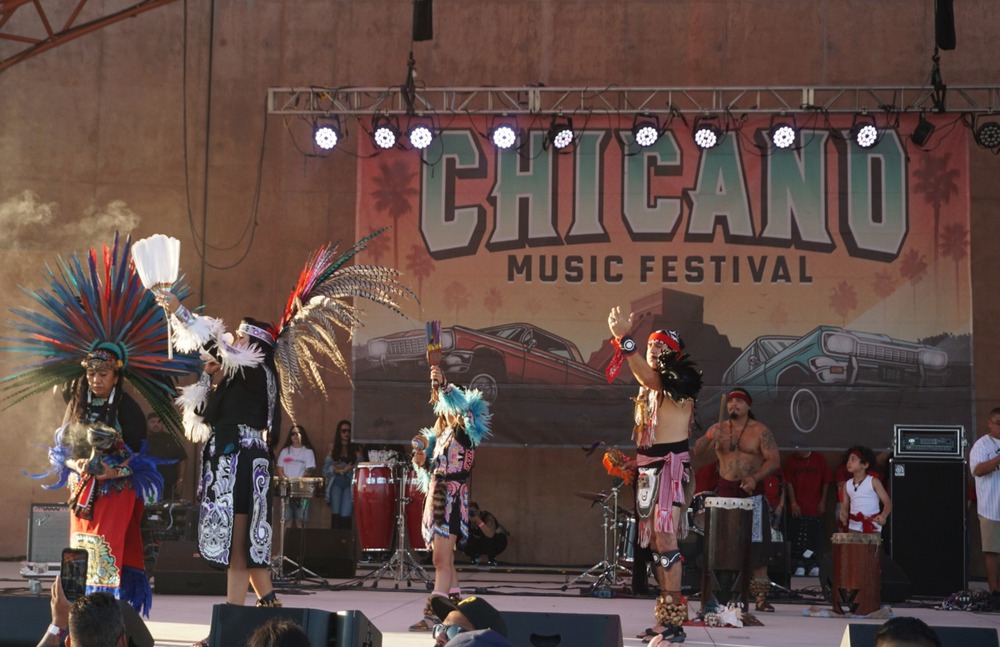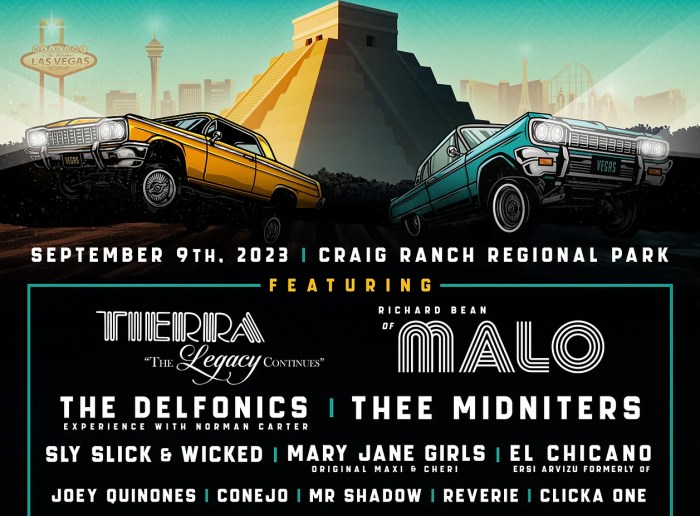Chicano Music Festival: More than just a concert, it’s a vibrant tapestry woven from decades of history, musical innovation, and powerful cultural expression. From its humble beginnings, the festival has evolved into a significant force, shaping not only the landscape of Chicano music but also the socio-cultural fabric of the United States. This exploration delves into the festival’s rich history, the diverse musical genres represented, its profound social impact, and the significant economic contributions it makes to communities across the nation.
Prepare to be captivated by the energy, the artistry, and the enduring legacy of this vital cultural event.
This deep dive will explore the evolution of Chicano Music Festivals, highlighting key moments and influential figures. We’ll examine the diverse musical genres, from traditional Mexican sounds to contemporary fusions, and unpack the socio-cultural significance of these festivals as platforms for cultural preservation, social activism, and community building. Finally, we’ll analyze the economic impact, showcasing the significant contributions these events make to local economies.
Get ready for a compelling journey through the heart and soul of Chicano culture.
Musical Genres Featured at Chicano Music Festivals

Chicano music festivals are vibrant celebrations of a rich and diverse musical heritage, showcasing a captivating blend of genres that reflect the multifaceted cultural landscape of the Chicano community. These festivals aren’t just about entertainment; they’re powerful platforms for cultural preservation, artistic expression, and community building. Understanding the musical genres represented provides insight into the evolution and dynamism of Chicano identity.
The lineup at any given Chicano music festival is a testament to the genre’s fluidity and evolution. It’s a tapestry woven from threads of traditional Mexican music, infused with the sounds of American popular culture, resulting in a unique and captivating sonic experience. This fusion is a key characteristic that sets Chicano music apart and makes its festivals so compelling.
Musical Genres at Chicano Music Festivals
Chicano music festivals typically feature a broad spectrum of genres, often reflecting the diverse regional and generational experiences within the Chicano community. Common genres include Norteño, Tejano, Banda, Conjunto, Lowrider music, and Hip Hop, along with their numerous subgenres and fusions. These genres often intertwine, creating a unique and dynamic musical landscape.
| Genre | Origin | Characteristics | Prominent Artists |
|---|---|---|---|
| Norteño | Northern Mexico | Accordion-based, often featuring vocals and upbeat rhythms. | Los Tigres del Norte, Intocable |
| Tejano | Texas | Blend of Mexican and American styles, often incorporating elements of country, polka, and R&B. | Selena, Emilio Navaira |
| Banda | Sinaloa, Mexico | Characterized by the use of brass instruments, creating a powerful and festive sound. | Banda El Recodo, La Banda Limón |
| Conjunto | Texas | Polka-influenced style, often featuring accordion and bajo sexto. | Flaco Jiménez, Santiago Jiménez Jr. |
| Lowrider Music | California | Often incorporates elements of R&B, soul, and funk, reflecting the car culture. | War, Tierra |
| Hip Hop | United States | Chicano Hip Hop often incorporates themes of social justice, cultural pride, and community. | Cypress Hill, Rage Against the Machine (partially) |
The Fusion of Musical Styles in Chicano Music, Chicano Music Festival
The fusion of musical styles is a defining characteristic of Chicano music. Artists frequently blend traditional Mexican genres with American popular music, creating a unique sound that reflects the bicultural experiences of the Chicano community. For example, Tejano music seamlessly incorporates elements of country, R&B, and pop, while Lowrider music fuses soul, funk, and R&B with traditional Mexican rhythms.
This fusion isn’t just a stylistic choice; it’s a powerful expression of identity, demonstrating the ability to navigate and synthesize diverse cultural influences.
The Role of Traditional Mexican Music
Traditional Mexican music serves as a foundational element for many Chicano musical genres. Genres like Norteño, Banda, and Conjunto are rooted in Mexican musical traditions, but they have evolved and adapted over time, incorporating new influences and reflecting the changing experiences of the Chicano community. This continuous evolution demonstrates the enduring power of tradition while simultaneously showcasing the adaptability and creativity of Chicano artists.
The presence of these traditional genres in Chicano music festivals highlights the importance of preserving and celebrating this rich cultural heritage.
Visual Representation of Chicano Music Festivals

Chicano music festivals are vibrant celebrations of culture, music, and community, and their visual aspects are as crucial to the experience as the music itself. The overall aesthetic is a powerful expression of Chicano identity, blending traditional elements with contemporary styles to create a unique and unforgettable atmosphere. These festivals are not just about the music; they’re a visual feast reflecting generations of artistic expression and cultural pride.The visual landscape of a Chicano music festival is a dynamic tapestry woven from various threads of color, sound, and movement.
From the clothing worn by attendees to the artistic installations dotting the festival grounds, every detail contributes to the overall immersive experience. This visual richness is a key component of the festival’s success, attracting attendees and creating a powerful sense of shared identity and community.
Attire and Decorations at Chicano Music Festivals
Attendees often embrace bold and vibrant colors, reflecting the rich hues found in traditional Mexican clothing and art. Think bright reds, yellows, greens, and blues, often incorporated into clothing styles like embroidered blouses, vibrant skirts, and distinctive bandanas. Many will wear clothing showcasing Chicano pride, featuring imagery like Aztec designs, lowrider themes, or political statements relevant to the Chicano community.
Decorations at the festival typically include papel picado (perforated paper banners), vibrant murals depicting important figures and historical events, and traditional folk art pieces, all contributing to the lively and festive ambiance. These visual cues immediately immerse attendees in the rich cultural heritage of the Chicano community.
Stage Design, Lighting, and Audience Interaction
The stage design itself often reflects the blend of traditional and modern aesthetics. It might incorporate elements of traditional Mexican architecture, such as arches and intricate patterns, while also incorporating modern lighting and sound technology to create a visually stunning spectacle. Lighting plays a crucial role in setting the mood, with vibrant colors used to highlight the performers and create an energetic atmosphere.
Audience interaction is vital; the crowd is an active participant in the visual spectacle, often dancing, singing along, and interacting with performers, creating a dynamic and lively visual experience. This constant movement and engagement further enhance the overall visual impact of the festival.
Art and Visual Displays Expressing Chicano Identity
Art installations and visual displays serve as powerful mediums for expressing Chicano identity and culture. These often include murals depicting historical figures, important events, and cultural symbols; artistic representations of traditional Mexican crafts; and contemporary art pieces reflecting the experiences and perspectives of the Chicano community. These displays are not merely decorations; they are storytelling tools, providing visual narratives that educate, inspire, and foster a sense of shared identity among attendees.
For example, a large-scale mural depicting César Chávez might be displayed prominently, serving as a visual reminder of the Chicano movement’s struggle for civil rights.
Visual Representation of a Hypothetical Chicano Music Festival
Imagine a festival held in a sun-drenched outdoor space, perhaps a sprawling park or a vibrant city plaza. The setting is adorned with papel picado banners fluttering in the breeze, their intricate designs casting playful shadows on the ground. Large-scale murals, painted in vibrant colors, depict significant moments in Chicano history and celebrate iconic figures of the community.
The stage is designed as a stylized representation of a traditional Mexican hacienda, with intricate carvings and vibrant colors, enhanced by dynamic lighting that shifts and changes throughout the performances. Attendees, dressed in a kaleidoscope of colorful clothing, are engaged in lively dancing and singing, creating a wave of movement and energy that is as visually captivating as the music itself.
Throughout the festival grounds, smaller art installations and displays showcase the diversity of Chicano artistic expression, further enriching the overall visual experience. This carefully curated visual landscape creates an immersive and unforgettable experience that celebrates the rich heritage and vibrant culture of the Chicano community.
The Chicano Music Festival stands as a testament to the enduring power of music and culture. It’s a dynamic celebration that transcends mere entertainment; it’s a vital force for preserving heritage, fostering community, and driving economic growth. From its roots in grassroots movements to its current status as a major cultural event, the festival continues to evolve, reflecting the ever-changing landscape of Chicano identity and artistic expression.
Its legacy extends far beyond the stage, leaving an indelible mark on the communities it serves and the broader cultural landscape of the United States. The vibrant energy, diverse sounds, and powerful message of unity and cultural pride ensure that the Chicano Music Festival will continue to thrive for generations to come.